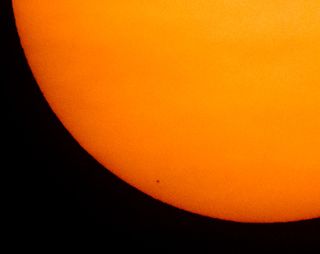Mercury's march across the sun today (Nov. 11) is due to a weird and wild set of planetary alignments, according to NASA. Usually the planet sails above or below the sun, from Earth's perspective, but today something stranger is happening — a transit event, which only happens 13 or 14 times a century.
"The planets go around the sun in roughly a plane, like a pancake," NASA heliophysicist Alex Young told Space.com. But it's not a perfect pancake, because the planets are slightly tilted with respect to one another.
But every once in a while, the planets do line up "just right," he said, and when that happens, "you see these little black planets go across the disk of the sun." In fact, Mercury and Venus are the only planets that can pass across the sun from our point of view, because they are closer to the sun than we are.

Mercury transited the sun on Nov. 11, 2019, as seen from Washington, D.C.
(Image credit: NASA/Bill Ingalls)
Mercury's transit schedule is far more irregular than Venus', scattering transits across a century roughly 13 or 14 times. Due to planetary-alignment patterns, Venus transits happen in pairs, each pair separated by a century. This means if you missed the last Venus transit in 2012, you likely won't see it happen in your lifetime, as the next one is set for the year 2117. But the next Mercury transit may be more feasible for astronomy fans: It's set to happen in 2032.
Just don't try to find Mercury on the sun with your naked eyes — it's dangerous, and besides, Mercury is too small to see anyway. Use proper filters on your telescope or binoculars to check out the planet, which only ranges from about 1/160 to 1/190 the diameter of the sun. That's "very, very small," pointed out Young.
If you are a fan of watching celestial objects align, however, you'll have more frequent luck with eclipses. Solar eclipses happen when the moon passes in front of the sun from Earth's perspective; lunar eclipses happen when the moon passes into the shadow of our planet. These can be observed from anywhere on Earth and tend to occur about eight months apart, Young said. While lunar eclipses are totally safe to view with your unprotected eyes, you will need proper solar equipment for viewing a solar eclipse.
Historically, planetary transits such as today's Mercury phenomenon were great for science because they helped astronomers figure out the distance to our sun. While we use radar measurements today for distance measuring, we still use planetary transits in another way — to find other planets outside of our solar system as they swing across their own stars.
NASA's Kepler telescope used this method to find thousands of exoplanets, Young said, and the agency's newer Transiting Exoplanet Survey Satellite (TESS) is expected to find tens of thousands. TESS will also act as a wayfinder for NASA's James Webb Space Telescope, which can look at some of the closer and larger ones for signs of their planetary atmosphere, he added.
Follow Elizabeth Howell on Twitter @howellspace. Follow us on Twitter @Spacedotcom and on Facebook.

Need more space? Subscribe to our sister title "All About Space" Magazine for the latest amazing news from the final frontier!
(Image credit: All About Space)
https://www.space.com/why-mercury-transit-2019-is-exciting-nasa-video.html
2019-11-11 17:10:00Z
52780432936320
Bagikan Berita Ini














0 Response to "This NASA Scientist Is So Excited About the Mercury Transit of 2019. Here's Why - Space.com"
Post a Comment